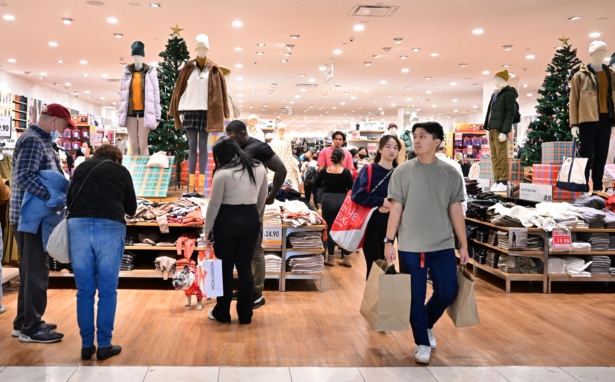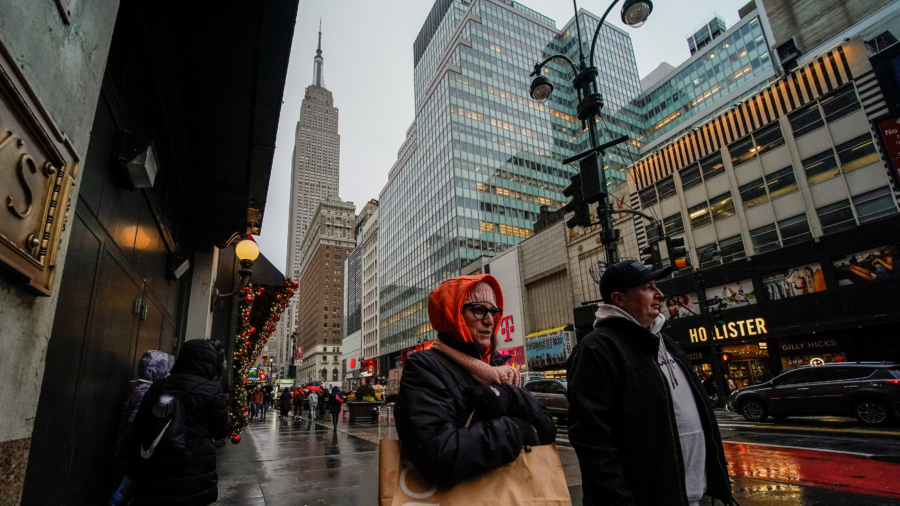WASHINGTON—U.S. consumer spending barely rose in November, while annual inflation increased at its slowest pace in 13 months, but demand is probably not cooling fast enough to discourage the Federal Reserve from driving interest rates to higher levels next year.
Slowing economic activity amid rising borrowing costs was also flagged by other data from the Commerce Department on Friday showing a modest gain in orders for locally manufactured capital goods last month. Shipments of these goods, which are a proxy for business spending on equipment, fell.
The U.S. central bank is trying to slow demand for everything from housing to labor as it fights to bring inflation back to its 2 percent target.
“Consumers are starting to pull back and businesses likely won’t be far behind as the full weight of tighter monetary policy and weaker financial conditions bears down on the economy in 2023,” said Sal Guatieri, a senior economist at BMO Capital Markets in Toronto.
Consumer spending, which accounts for more than two-thirds of U.S. economic activity, edged up 0.1 percent. Data for October was revised up to show spending surging 0.9 percent instead of 0.8 percent as previously reported. Economists polled by Reuters had forecast consumer spending rising 0.2 percent.
Some of the moderation in spending last month reflected a shift of demand from goods to services. Slowing price increases for some goods also lowered the dollar amount of consumer spending.
Spending on goods fell 1.0 percent, led by decreases in purchases of motor vehicles. Lower gasoline prices also weighed, with additional drags on sales coming from household furnishings and other equipment as well as recreational goods and vehicles.
Outlays on services increased 0.7 percent, lifted by housing and utilities as well as financial services and insurance. They offset decreases in air transportation services.
U.S. stocks opened lower. The dollar was steady against a basket of currencies. U.S. Treasury prices fell.
Goods Orders Slow
Nevertheless, consumer spending is on track to provide another lift to economic growth this quarter, after teaming up with exports to boost gross domestic product in the third quarter. The economy grew at a 3.2 percent annualized rate last quarter after contracting in the first half of the year.

Growth estimates for the fourth quarter are as high as a 2.7 percent pace. Consumer spending is being driven by solid wage gains, thanks to a tight labor market, as well as savings accumulated during first year of the COVID-19 pandemic.
The Fed last week hiked its policy rate by 50 basis points to a 4.25 percent–4.50 percent range, the highest since late 2007. Fed officials expect the rate to rise to between 5.00 percent and 5.25 percent next year, a level that could be sustained for a while.
Higher borrowing costs, fast-depleting savings, and diminishing household wealth could stifle consumer spending, and tip the economy into recession next year.
Personal income rose 0.4 percent last month after jumping 0.7 percent in October. The saving rate rose to 2.4 percent from 2.2 percent in October.
The personal consumption expenditures (PCE) price index rose 0.1 percent last month after climbing 0.4 percent in October. In the 12 months through November, the PCE price index increased 5.5 percent. That was the smallest annual gain since October 2021 and followed a 6.1 percent advance in October.
Excluding the volatile food and energy components, the PCE price index gained 0.2 percent after increasing 0.3 percent in October. The so-called core PCE price index climbed 4.7 percent on a year-on-year basis in November, also the smallest rise since October 2021, after increasing 5.0 percent in October.
The Fed tracks the PCE price indexes for monetary policy. Other inflation measures have also shown signs of slowing.
Consumer prices rose less than expected for a second straight month in November. Consumers’ one-year inflation expectations also moderated in December, strengthening views that price pressures peaked several months ago.
In another report on Friday, the Commerce Department said orders for non-defense capital goods excluding aircraft, a closely watched proxy for business spending plans, rose 0.2 percent in November. These so-called core capital goods orders increased 0.3 percent in October. They gained 8.8 percent on a year-on-year basis.
The data is not adjusted for inflation. Slowing price increases, a strong dollar, and the shift in spending from goods to services likely contributed to the moderation in core capital goods orders. That is hurting manufacturing, which accounts for 11.3 percent of the economy.
Shipments of core capital goods dipped 0.1 percent after increasing 1.4 percent in October. Core capital goods shipments are used to calculate equipment spending in the gross domestic product measurement. Business spending on equipment contributed to the economy’s rebound last quarter.
By Lucia Mutikani

